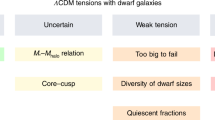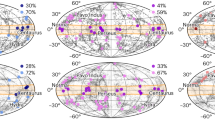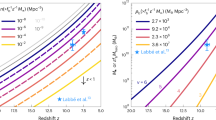Abstract
The standard cold dark matter plus cosmological constant model predicts that galaxies form within dark-matter haloes, and that low-mass galaxies are more dark-matter dominated than massive ones. The unexpected discovery of two low-mass galaxies lacking dark matter immediately provoked concerns about the standard cosmology and ignited explorations of alternatives, including self-interacting dark matter and modified gravity. Apprehension grew after several cosmological simulations using the conventional model failed to form adequate numerical analogues with comparable internal characteristics (stellar masses, sizes, velocity dispersions and morphologies). Here we show that the standard paradigm naturally produces galaxies lacking dark matter with internal characteristics in agreement with observations. Using a state-of-the-art cosmological simulation and a meticulous galaxy-identification technique, we find that extreme close encounters with massive neighbours can be responsible for this. We predict that ~30% of massive central galaxies (with at least 1011 solar masses in stars) harbour at least one dark-matter-deficient satellite (with 108–109 solar masses in stars). This distinctive class of galaxies provides an additional layer in our understanding of the role of interactions in shaping galactic properties. Future observations surveying galaxies in the aforementioned regime will provide a crucial test of this scenario.
This is a preview of subscription content, access via your institution
Access options
Access Nature and 54 other Nature Portfolio journals
Get Nature+, our best-value online-access subscription
$29.99 / 30 days
cancel any time
Subscribe to this journal
Receive 12 digital issues and online access to articles
$119.00 per year
only $9.92 per issue
Buy this article
- Purchase on Springer Link
- Instant access to full article PDF
Prices may be subject to local taxes which are calculated during checkout




Similar content being viewed by others
Data availability
The datasets generated during and/or analysed during the current study are available from the corresponding author on reasonable request, contingent on approval by the FIRE Collaboration on a case-by-case basis.
Code availability
The codes we used are available as follows: GIZMO, https://bitbucket.org/phopkins/gizmo-public/src/master; yt, https://yt-project.org; AHF, http://popia.ft.uam.es/AHF/Download.html; FIRE Studio, https://github.com/agurvich/FIRE_studio; WebPlotDigitizer, https://apps.automeris.io/wpd.The Python scripts used to create the Figs. 1–4 and Supplementary Figs. 1–9 are available from the corresponding author on reasonable request, contingent on approval by the FIRE Collaboration on a case-by-case basis.
References
Zwicky, E. Die rotverschiebung von extragalaktischen nebeln. Helv. Phys. Acta 6, 110–127 (1933).
Rubin, B. C. & Ford, W. K. Jr Rotation of the Andromeda Nebula from a spectroscopic survey of emission regions. Astrophys. J. 159, 379 (1970).
White, S. D. M. & Rees, M. J. Core condensation in heavy halos: a two-stage theory for galaxy formation and clustering. Mon. Not. R. Astron. Soc. 183, 341–358 (1978).
Behroozi, P. S., Wechsler, R. H. & Conroy, C. The average star formation histories of galaxies in dark matter halos from z=0-8. Astrophys. J. 770, 57 (2013).
Tollerud, E. et al. From galaxy clusters to ultra-faint dwarf spheroidals: a fundamental curve connecting dispersion-supported galaxies to their dark matter halos. Astrophys. J. 726, 23 (2011).
van Dokkum, P. et al. A galaxy lacking dark matter. Nature 555, 629–632 (2018).
van Dokkum, P. et al. A second galaxy missing dark matter in the NGC 1052 group. Astrophys. J. Lett. 874, 1 (2019).
Haslbauer, M., Banik, I., Kroupa, P. & Grishunin, K. The ultra-diffuse dwarf galaxies NGC 1052-DF2 and 1052-DF4 are in conflict with standard cosmology. Mon. Not. R. Astron. Soc. 489, 2634–2651 (2019).
Yu, H., Ratra, B. & Wang, F.-J. Dark matter deficient galaxies in the Illustris flat-Λ CDM model structure formation simulation. Preprint at https://arxiv.org/abs/1809.05938 (2018).
Jing, Y. et al. Dark-matter-deficient galaxies in hydrodynamical simulations. Mon. Not. R. Astron. Soc. 488, 3298–3307 (2009).
Haslbauer, M. et al. Galaxies lacking dark matter in the Illustris simulation. Astron. Astrophys. 626, A47 (2019).
Carleton, T. et al. The formation of ultra diffuse galaxies in cored dark matter haloes through tidal stripping and heating. Mon. Not. R. Astron. Soc. 485, 382–395 (2019).
Sales, L. V. et al. The formation of ultradiffuse galaxies in clusters. Mon. Not. R. Astron. Soc. 494, 1848–1858 (2020).
Saulder, C. et al. Isolated dark-matter-deprived galaxies in hydrodynamical simulations: real objects or artifacts? Mon. Not. R. Astron. Soc. 491, 1278–1286 (2020).
Shin, E. et al. Dark matter deficient galaxies produced via high-velocity galaxy collisions in high-resolution numerical simulations. Astrophys. J. 899, 25 (2020).
Applebaum, E. et al. Ultrafaint dwarfs in a Milky Way context: introducing the Mint condition DC Justice League simulations. Astrophys. J. 909, 96 (2021).
Jackson, R. A. et al. Dark matter-deficient dwarf galaxies form via tidal stripping of dark matter in interactions with massive companions. Mon. Not. R. Astron. Soc. 502, 1785–1796 (2021).
Wright, A. C. The formation of isolated ultradiffuse galaxies in ROMULUS25. Mon. Not. R. Astron. Soc. 502, 5370–5389 (2021).
Ogiya, G. Tidal stripping as a possible origin of the ultra diffuse galaxy lacking dark matter. Mon. Not. R. Astron. Soc. 480, L106–L110 (2018).
Huo, R. Refracting into ultra-diffuse galaxy NGC 1052-DF2 by passing near the centre of NGC 1052. Mon. Not. R. Astron. Soc. 495, L144–L148 (2020).
Nusser, A. A scenario for ultradiffuse satellite galaxies with low velocity dispersions: the case of [KKS 2000]04. Astrophys. J. 893, 66 (2020).
Yang, D., Yu, H.-B. & An, H. Self-interacting dark matter and the origin of ultradiffuse galaxies NGC1052-DF2 and -DF4. Phys. Rev. Lett. 125, 111105 (2020).
Macciò, A. V. et al. Creating a galaxy lacking dark matter in a dark matter-dominated universe. Mon. Not. R. Astron. Soc. 501, 693–700 (2021).
Hopkins, P. F. et al. FIRE-2 simulations: physics versus numerics in galaxy formation. Mon. Not. R. Astron. Soc. 480, 800–863 (2018).
Faucher-Giguére, C.-A. Recent progress in simulating galaxy formation from the largest to the smallest scales. Nat. Astron. 2, 368–373 (2018).
Kroupa, P. et al. Does the galaxy NGC1052-DF2 falsify Milgromian dynamics?. Nature 561, E4–E5 (2018).
Moffat, J. W. & Toth, V. T. NGC 1052-DF2 and modified gravity (MOG) without dark matter. Mon. Not. R. Astron. Soc. 482, L1–L3 (2019).
Khalifeh, A. R. & Jimenez, R. Dwarf galaxies without dark matter: constraints on modified gravity. Mon. Not. R. Astron. Soc. 501, 254–260 (2021).
Famaey, B., McGaugh, S. & Milgrom, M. MOND and the dynamics of NGC 1052-DF2. Mon. Not. R. Astron. Soc. 480, 473–476 (2018).
Haghi, H. et al. A new formulation of the external field effect in MOND and numerical simulations of ultra-diffuse dwarf galaxies – application to NGC 1052-DF2 and NGC 1052-DF4. Mon. Not. R. Astron. Soc. 487, 2442–2454 (2019).
Shen, Z. et al. A tip of the red giant branch distance of 22.1 ± 1.2 Mpc to the dark matter deficient galaxy NGC 1052-DF2 from 40 orbits of Hubble Space Telescope imaging. Astrophys. J. Lett. 914, L12 (2021).
Danieli, S. et al. A tip of the red giant branch distance to the dark matter deficient galaxy NGC 1052-DF4 from Deep Hubble Space Telescope data. Astrophys. J. Lett. 895, L4 (2020).
Forbes, D. A. et al. The SLUGGS Survey: stellar masses and effective radii of early-type galaxies from Spitzer Space Telescope 3.6 μm imaging. Mon. Not. R. Astron. Soc. 464, 4611–4623 (2017).
Zahid, H. J., Sohn, J. & Geller, M. J. Stellar velocity dispersion: linking quiescent galaxies to their dark matter haloes. Astrophys. J. 859, 96 (2018).
Danieli, S. et al. Still missing dark matter: KCWI high-resolution stellar kinematics of NGC1052-DF2. Astrophys. J. Lett. 874, L12 (2019).
Mancera Piña, P. et al. Off the baryonic Tully-Fisher relation: a population of baryon-dominated ultra-diffuse galaxies. Astrophys. J. 883, L33 (2019).
Guo, Q. et al. Further evidence for a population of dark-matter-deficient dwarf galaxies. Nat. Astron. 4, 246–251 (2020).
Mancera Piña, P. et al. No need for dark matter: resolved kinematics of the ultra-diffuse galaxy AGC 114905. Preprint at https://arxiv.org/abs/2112.00017 (2021).
Wolf, J. et al. Accurate masses for dispersion-supported galaxies. Mon. Not. R. Astron. Soc. 406, 1220–1237 (2010).
Sérsic, J. L. Influence of the atmospheric and instrumental dispersion on the brightness distribution in a galaxy. Bol. Asoc.Argent. Astron. 6, 41–43 (1963).
Sardone, A. et al. Constraints on the HI mass of NGC 1052-DF2. Astrophys. J. 871, 31 (2019).
Peñarrubia, J. et al. The impact of dark matter cusps and cores on the satellite galaxy population around spiral galaxies. Mon. Not. R. Astron. Soc. 406, 1290–1305 (2010).
Bryan, S. E. Influence of baryons on the orbital structure of dark matter haloes. Mon. Not. R. Astron. Soc. 422, 1863–1879 (2013).
Valluri, M. et al. Probing the shape and history of the Milky Way halo with orbital spectral analysis. Mon. Not. R. Astron. Soc. 419, 1951–1969 (2013).
Zhu, Q. et al. Baryonic impact on the dark matter orbital properties of Milky Way-sized haloes. Mon. Not. R. Astron. Soc. 466, 3876–3886 (2017).
Mowla, L., van der Wel, A., van Dokkum, P. & Miller, T. B. A mass-dependent slope of the galaxy size-mass relation out to z ~ 3: further evidence for a direct relation between median galaxy size and median halo mass. Astrophys. J. Lett. 872, L13 (2019).
Wetzel, A. R. et al. Galaxy evolution near groups and clusters: ejected satellites and the spatial extent of environmental quenching. Mon. Not. R. Astron. Soc. 439, 2687–2700 (2014).
Shen, Z. et al. A complex luminosity function for the anomalous globular clusters in NGC 1052-DF2 and NGC 1052-DF4. Astrophys. J. 909, 179 (2021).
Kim, J. H. et al. Formation of globular cluster candidates in merging proto-galaxies at high redshift: a view from the FIRE cosmological simulations. Mon. Not. R. Astron. Soc. 474, 4232–4244 (2018).
Ma, X. et al. Self-consistent proto-globular cluster formation in cosmological simulations of high-redshift galaxies. Mon. Not. R. Astron. Soc. 493, 4315–4332 (2020).
Fensch, J. et al. The ultra-diffuse galaxy NGC 1052-DF2 with MUSE II. The population of DF2: stars, clusters, and planetary nebulae. Astron. Astrophys. 625, A77 (2019).
Knollmann, S. R. & Knebe, A. AHF: AMIGA’s Halo Finder. Astrophys. J. Suppl. Ser. 182, 608–624 (2009).
Knebe, A. et al. Haloes gone MAD: the Halo-Finder Comparison Project. Mon. Not. R. Astron. Soc. 415, 2293–2318 (2011).
Bryan, G. L. & Norman, M. L. Statistical properties of X-ray clusters: analytic and numerical comparisons. Astrophys. J. 495, 80 (1998).
Turk, M. J. et al. yt: a multi-code analysis toolkit for astrophysical simulation data. Astrophys. J. Suppl. Ser. 192, 96 (2011).
Elmegreen, B. G., Kaufman, M. & Thomasson, M. An interaction model for the formation of dwarf galaxies and 108 Msun clouds in Spiral Disks. Astrophys. J. 412, 90 (1993).
Acknowledgements
Sabbatical leave support from Pomona College and the Harry and Grace Steele Foundation (J.M.). NASA Hubble Fellowship grant number HST-HF2-51454.001-A awarded by the Space Telescope Science Institute, which is operated by the Association of Universities for Research in Astronomy, Incorporated, under NASA contract number NAS5-26555 (S.D.). NSF grant number AST-1910346 (J.S.B., F.J.M. and S.Y.). Swiss National Science Foundation grant numbers PP00P2_157591, PP00P2_194814 and 200021_188552; Swiss National Supercomputing (CSCS) project IDs s697 and s698 (R.F.). NSF Research Grant numbers 1911233 and 20009234, NSF CAREER grant number 1455342, NASA grant numbers 80NSSC18K0562 and HST-AR-15800.001-A (P.F.H.). NASA grant number 80NSSSC20K1469 (A.L.). Gary McCue postdoctoral fellowship through the Center for Cosmology at UC Irvine (Z.H.). National Science Foundation Graduate Research Fellowship under grant number DGE-1839285 (C.K.). NSF CAREER grant number 2045928; NASA ATP grant numbers 80NSSC18K1097 and 80NSSC20K0513; HST grant numbers AR-15809 and GO-15902 from STScI; Scialog Award from the Heising-Simons Foundation; Hellman Fellowship (A.W.). NSF grant number AST-2009687 and by the Flatiron Institute, which is supported by the Simons Foundation (D.A.-A.). NSF CAREER award number AST-1752913, NSF grant number AST-1910346, NASA grant numbers NNX17AG29G and HST-AR-15006, HST-AR-15809, HST-GO-15658, HST-GO-15901, HST-GO-15902, HST-AR-16159 and HST-GO-16226 from STScI (M.B.-K.). Simons Investigator Award from the Simons Foundation; NSF grant number AST-1715070 (E.Q.). NSF through grant numbers AST-1715216 and CAREER award AST-1652522; by NASA through grant number 17-ATP17-0067; by STScI through grant number HST-AR-16124.001-A; and by the Research Corporation for Science Advancement through a Cottrell Scholar Award and a Scialog Award (C.-A.F.-G.). NSF grant number AST-1715101 (D.K.). Numerical calculations were run on the Caltech compute cluster “Wheeler,” allocations FTA-HopkinsAST20016 supported by the NSF and TACC and NASA HEC SMD-16-7592. We acknowledge PRACE for awarding us access to MareNostrum at the Barcelona Supercomputing Center (BSC), Spain. This research was partly carried out via the Frontera computing project at the Texas Advanced Computing Center. Frontera is made possible by National Science Foundation award number OAC-1818253. We acknowledge access to Piz Daint at the Swiss National Supercomputing Centre, Switzerland under the University of Zurich’s share with the project ID uzh18. Additional computing support was provided by S3IT resources at the University of Zurich. We thank Y. Jing for patiently answering every question we had regarding their 2019 paper, and for sharing the data we requested. We also thank P. van Dokkum, J. Hudgings, D. Whitaker, D. Tanenbaum and R. Gaines for comments on an earlier draft, and C. Hayward for data-transfer support. J.M. thanks J.S.B., P.F.H., P. Torrey and L. Hernquist for sabbatical-leave hospitality. J.M. (an astronomer of Indigenous ancestry, non-Cherokee) thanks D. Ingram (a Cherokee physicist) for sharing knowledge about the Cherokee Nation and cultural appropriation. This work was conducted on Tongva-Gabrielino land.
Author information
Authors and Affiliations
Contributions
J.M. conducted the analysis and designed the manuscript, with substantial input from S.D. and J.S.B. S.D. collected observational data from the literature and verified the theory–observations comparisons. R.F. ran the cosmological simulation used in this work. O.Ç. generated the halo catalogues and merger trees. A.G. provided support for the creation of mock images. A.L. and C.B.H. provided support with yt. C.K. calculated g-band effective radii, Sérsic indices and surface brightness contours. C.K. and F.J.M. calculated stellar ages, metallicities and colours; and S.D. conducted the observational comparison. J.S.B., R.F., O.Ç. and F.J.M. worked on the discussion of numerical stripping, with substantial input from F.J. Z.H. contributed to the literature comparison. All authors contributed to the final creation of the manuscript and figures.
Corresponding author
Ethics declarations
Competing interests
The authors declare no competing interests.
Peer review
Peer review information
Nature Astronomy thanks the anonymous reviewers for their contribution to the peer review of this work.
Additional information
Publisher’s note Springer Nature remains neutral with regard to jurisdictional claims in published maps and institutional affiliations.
Supplementary information
Supplementary Information
Supplementary Figs. 1–9, Tables 1–4 and Discussion.
Rights and permissions
About this article
Cite this article
Moreno, J., Danieli, S., Bullock, J.S. et al. Galaxies lacking dark matter produced by close encounters in a cosmological simulation. Nat Astron 6, 496–502 (2022). https://doi.org/10.1038/s41550-021-01598-4
Received:
Accepted:
Published:
Issue Date:
DOI: https://doi.org/10.1038/s41550-021-01598-4



